Top Natural Landmarks of Australia
Australia is home to some of the most awe-inspiring natural landmarks on Earth. From vibrant coral reefs and ancient rock formations to lush rainforests and sweeping coastal cliffs, these wonders are more than just photo ops. They’re living, breathing ecosystems that help define Australia’s identity. Each one offers a unique experience and contributes to the country’s reputation for biodiversity, adventure, and natural beauty.
Whether you’re dreaming of snorkeling the Great Barrier Reef, hiking through a national park, or marveling at a pink lake in Western Australia, these must-visit destinations belong at the top of your travel bucket list. They highlight the country’s deep Aboriginal cultural ties, impressive geological history, and abundant wildlife, making Australia’s landscape unlike any other.
Great Barrier Reef
The Great Barrier Reef, the world’s largest coral reef system, is one of the most famous natural landmarks in Australia. Stretching over 1,400 miles off the coast of Queensland, it’s so large it can be seen from space. Beyond its beauty, the reef plays a vital role in global marine biodiversity, hosting over 1,500 species of fish, colorful corals, sea turtles, rays, and more.
To protect this fragile ecosystem, responsible tourism is key. Join eco-certified snorkeling and diving tours that prioritize sustainability. Stay on low-impact island resorts or research-based liveaboards to get closer to the reef while supporting conservation efforts in Australia. Whether you’re an experienced diver or a first-time snorkeler, the reef’s vibrant underwater world is a once-in-a-lifetime experience.
For those looking to explore beyond the water, head to Ningaloo Reef in Western Australia, a less-crowded alternative that offers the chance to swim with whale sharks during migration season.
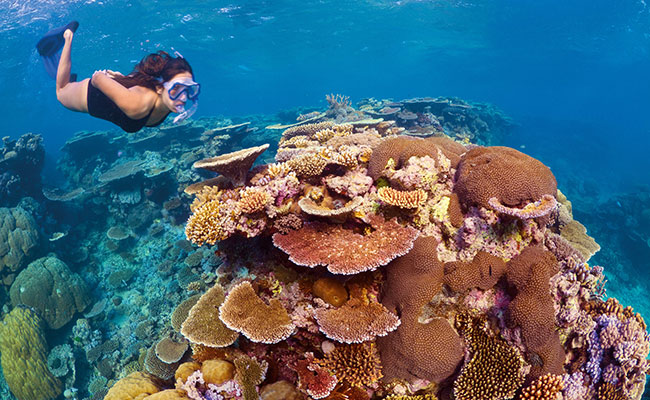
Snorkeling amongst vibrant corals in the Great Barrier Reef. Image: Tourism Queensland
Uluru
Rising dramatically from the flat desert landscape of the Red Centre, Uluru (also known as Ayers Rock) holds immense cultural significance for the Anangu people. This giant sandstone monolith is sacred, representing creation stories that are thousands of years old.
Visiting Uluru respectfully involves understanding its importance. While climbing is no longer permitted, walking trails, guided tours, and Aboriginal cultural experiences offer immersive alternatives. Sunset and sunrise are magical times to witness the rock’s shifting hues.
Nearby Kakadu National Park, a UNESCO World Heritage Site, is another cultural and ecological treasure, blending ancient Aboriginal rock art with waterfalls, wetlands, and rich birdlife.
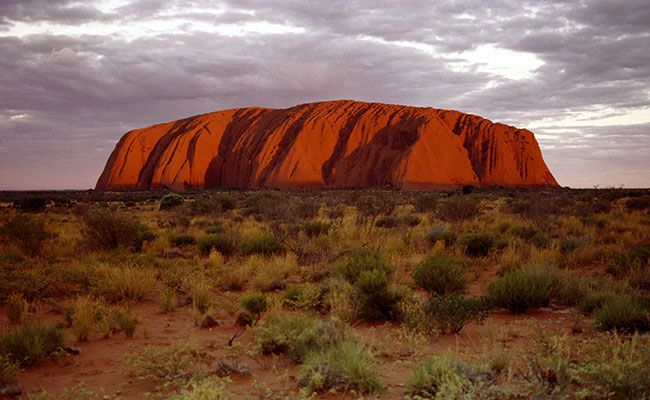
The magnificent Uluru Rock in Australia’s Red Centre. Image: Tourism Northern Territory
The Twelve Apostles
Located along the legendary Great Ocean Road, the Twelve Apostles are towering limestone stacks formed by relentless ocean erosion. Standing majestically off Victoria’s southern coast, they are among the most recognizable natural landmarks in Australia.
The best way to experience the Twelve Apostles is by visiting at sunrise or sunset when the golden light casts dramatic shadows on the cliffs. Several lookout points offer sweeping coastal views, but for a truly unforgettable perspective, book a scenic helicopter ride.
Make time to explore other stops along the Great Ocean Road, including Loch Ard Gorge, London Bridge, and nearby surf beaches. The region offers beauty year-round, but many travelers favor spring (September–November) and autumn (March–May) for milder weather and fewer crowds. Summer (December–February) offers warm days and full activity, though it draws more visitors. Whale watching also peaks in winter months along sections of the coast. Be sure to check local conditions before planning your drive.
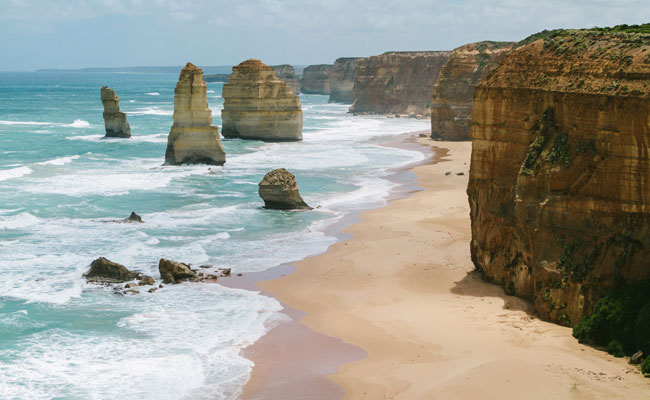
The Twelve Apostles are truly a breathtaking sight. Image: Tourism Australia
Exploring the Ancient Bungle Bungles
The Bungle Bungles in Purnululu National Park, Western Australia, are striking dome-shaped formations with black and orange stripes. They’re unlike anything else in the world. Formed over 350 million years ago, they remain one of the most remote and rewarding destinations in the country. The national park is open during their dry season, typically from April to November each year. The park closes for the wet season, but you may be able to visit the Bungles via a guided tour from December to March.
Getting there can be a challenge, but it’s well worth the effort. Book a guided tour from Kununurra or Broome or take a scenic flight for bird’s-eye views of this geological wonder. Respectful visits also include learning about the site’s Aboriginal heritage and stories.
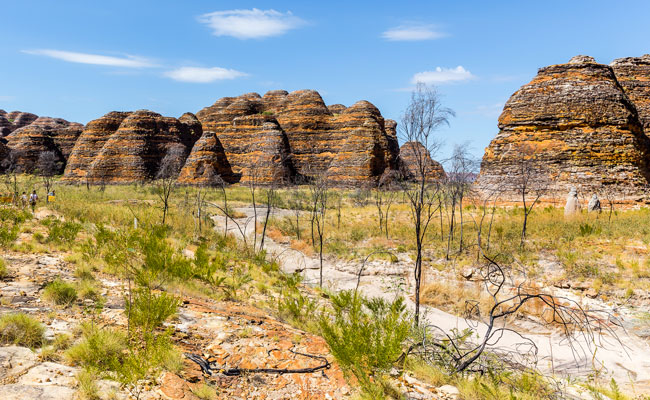
The Bungle Bungles are a very unique geologic formation. Image: Tourism Western Australia
Blue Mountains: A Hiker’s Paradise
Just west of Sydney, the Blue Mountains are a hiker’s dream. Covered in eucalyptus forests that give the area its distinctive blue haze, this UNESCO World Heritage Site offers dramatic cliffs, waterfalls, and gorges.
Popular trails like the Three Sisters Walk and Wentworth Falls cater to all fitness levels. The region is rich in biodiversity, home to rare plants and wildlife, and offers a true immersion into Australia’s natural beauty. Whether you’re after a relaxing stroll or a multi-day trek, the Blue Mountain region is a must for nature lovers.
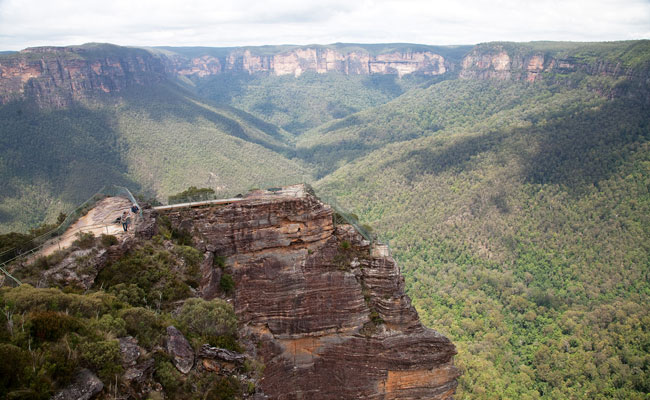
The majestic Blue Mountains. Image: Boutique Tours Australia
Ningaloo Reef
At Ningaloo Reef, you’ll find yourself surrounded by emerald lagoons, brilliant coral, and vibrant tropical fish! The Ningaloo Reef is the largest fringing coral reef in Australia and can be reached right from the shore, making it an amazing snorkeling destination. You can also swim with whale sharks or humpback whales! Beyond snorkeling, this UNESCO World Heritage-listed reef offers truly unforgettable encounters with marine life.
At Ningaloo Reef, you’ll find yourself surrounded by emerald lagoons, brilliant coral, and vibrant tropical fish! The reef, Australia’s largest fringing coral reef, can be reached right from shore, making it an amazing snorkeling destination. You can also swim with whale sharks and humpback whales, depending on the season.
Whale shark season generally runs from March to July (sometimes into August), with peak sightings in April to July.
Humpback whales migrate through from June through October, with July and August among the most active months.
Because these windows overlap, it’s possible, though not guaranteed, to swim with a whale shark one day and humpbacks the next. That rare possibility makes Ningaloo a standout destination for wildlife lovers and adventure seekers alike.
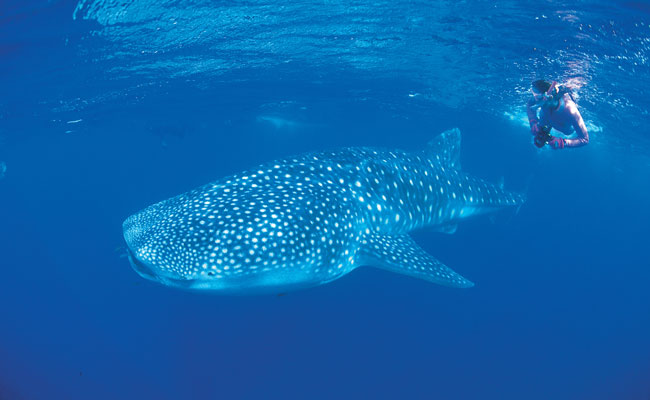
Whale sharks frequently visit Ningaloo Reef. Image: Sal Salis Ningaloo
K’Gari
K’Gari, located off the coast of Queensland, is the world’s largest sand island. Here you’ll find rainforests, 780-feet-high sand dunes, 100 freshwater lakes, and unique animals like wallabies, sugar gliders, echidnas, and dingoes!
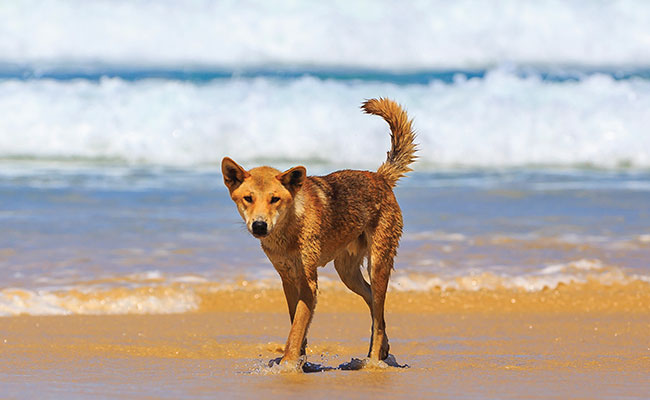
A dingo enjoys the beach on Fraser Island. Image: Tourism Queensland
Kakadu National Park
Kakadu National Park features the type of pristine outback scenery that inspired Crocodile Dundee. Within this massive wilderness in the Northern Territory, you’ll find incredible tropical biodiversity. Kakadu is home to 2,000 plant species, around one-third of all Australian bird species, and about one-fifth of all Australian mammals. It is also home to floodplains, tidal flats, and rocky outcrops. Aboriginal rock carvings are found throughout the area, as well as both freshwater and saltwater crocs.
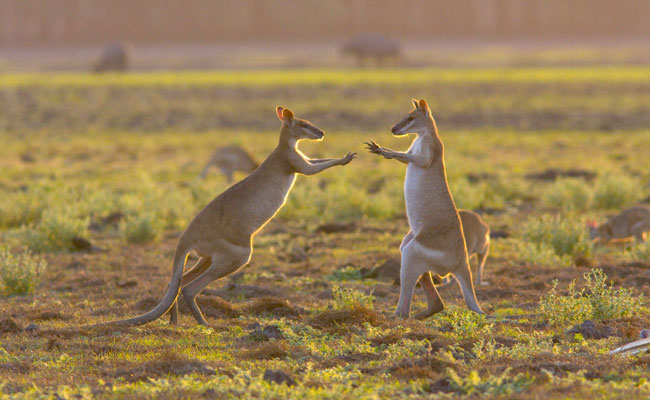
Wallabies playing in the Mary River floodplains. Image: Bamurru Plains
Lake Hillier
Lake Hillier is the most famous of remote Western Australia’s otherworldly pink lakes. Located on Middle Island, the bubblegum-pink lake makes a striking sight against the surrounding forest, white sandy beach, and turquoise ocean! Though you can see the lake on a boat excursion, we recommend viewing it on a scenic flight out of Esperance.
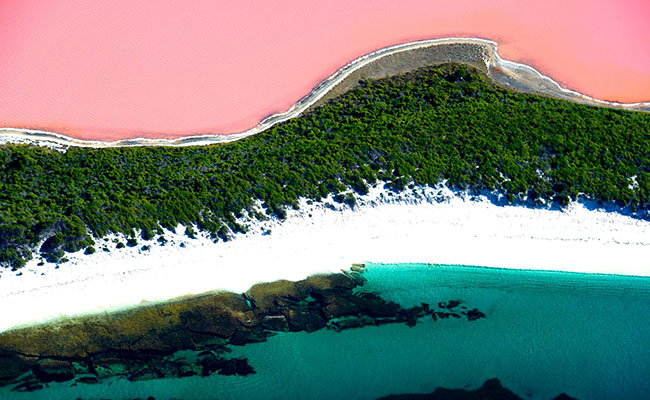
Lake Hillier is a striking shade of pink. Image: Tourism Western Australia
The Pinnacles
Located about 3 hours outside of Perth, the Pinnacles are limestone formations created roughly 30,000 years ago, as the receding oceans left deposits of seashells on shore. They rise several meters out of the sand in Nambung National Park on the remote western coast. You’re likely to see an amazing amount of wildlife here, including kangaroos, emus, and reptiles.
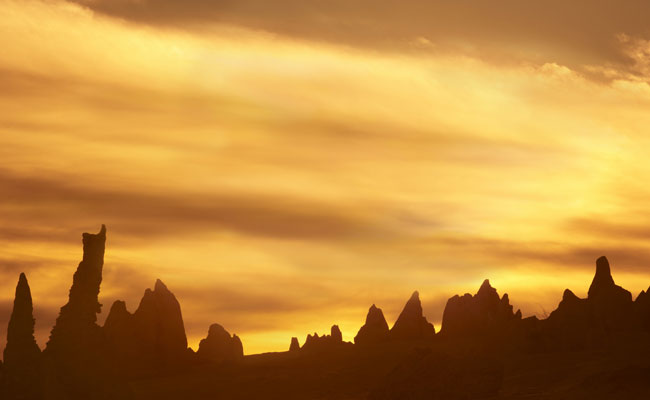
The Pinnacles seem to be otherworldly formations. Image: Tourism Western Australia
Ready to explore Australia’s natural wonders? Browse our Australian vacation packages or give us a call at 888-229-0082 to start planning the adventure of a lifetime!
Why These Natural Landmarks Deserve Our Respect
Australia’s natural wonders reflect the country’s rich environmental diversity and cultural legacy. From marine ecosystems like the Great Barrier Reef to ancient formations like Uluru, these places are more than just scenic—they’re sacred, vital, and fragile.
Travelers can help protect them by practicing wildife adventures responsibly, supporting national park initiatives, and respecting indigenous stories tied to the land. Sustainable travel ensures that these sites will continue to inspire future generations.
To hear what others have said about their experiences, check out our testimonials.